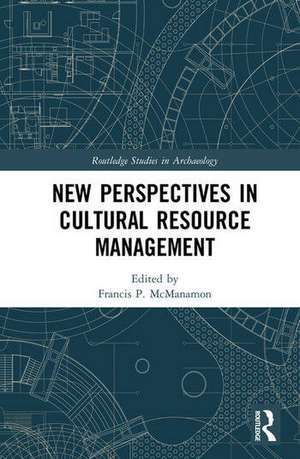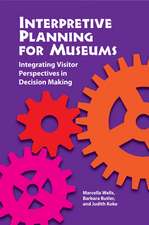New Perspectives in Cultural Resource Management: Routledge Studies in Archaeology
Editat de Francis P. McManamonen Limba Engleză Hardback – 18 sep 2017
| Toate formatele și edițiile | Preț | Express |
|---|---|---|
| Paperback (1) | 272.23 lei 6-8 săpt. | |
| Taylor & Francis – 12 dec 2019 | 272.23 lei 6-8 săpt. | |
| Hardback (1) | 643.87 lei 2 zile | |
| Taylor & Francis – 18 sep 2017 | 643.87 lei 2 zile |
Din seria Routledge Studies in Archaeology
-
 Preț: 310.36 lei
Preț: 310.36 lei -
 Preț: 311.41 lei
Preț: 311.41 lei -
 Preț: 311.41 lei
Preț: 311.41 lei - 18%
 Preț: 1108.37 lei
Preț: 1108.37 lei - 26%
 Preț: 766.16 lei
Preț: 766.16 lei - 25%
 Preț: 771.88 lei
Preț: 771.88 lei -
 Preț: 384.59 lei
Preț: 384.59 lei -
 Preț: 483.49 lei
Preț: 483.49 lei - 26%
 Preț: 822.76 lei
Preț: 822.76 lei -
 Preț: 389.38 lei
Preț: 389.38 lei - 25%
 Preț: 773.99 lei
Preț: 773.99 lei - 18%
 Preț: 1062.62 lei
Preț: 1062.62 lei -
 Preț: 423.30 lei
Preț: 423.30 lei -
 Preț: 389.66 lei
Preț: 389.66 lei -
 Preț: 389.66 lei
Preț: 389.66 lei -
 Preț: 389.66 lei
Preț: 389.66 lei - 18%
 Preț: 1106.02 lei
Preț: 1106.02 lei - 18%
 Preț: 1064.70 lei
Preț: 1064.70 lei -
 Preț: 389.38 lei
Preț: 389.38 lei - 18%
 Preț: 1059.14 lei
Preț: 1059.14 lei - 18%
 Preț: 1112.34 lei
Preț: 1112.34 lei - 18%
 Preț: 1114.70 lei
Preț: 1114.70 lei -
 Preț: 492.54 lei
Preț: 492.54 lei - 18%
 Preț: 1109.18 lei
Preț: 1109.18 lei - 25%
 Preț: 769.55 lei
Preț: 769.55 lei -
 Preț: 480.62 lei
Preț: 480.62 lei -
 Preț: 469.34 lei
Preț: 469.34 lei - 25%
 Preț: 766.70 lei
Preț: 766.70 lei - 18%
 Preț: 1072.71 lei
Preț: 1072.71 lei - 25%
 Preț: 770.62 lei
Preț: 770.62 lei - 25%
 Preț: 823.99 lei
Preț: 823.99 lei -
 Preț: 389.66 lei
Preț: 389.66 lei - 17%
 Preț: 256.87 lei
Preț: 256.87 lei - 18%
 Preț: 1060.52 lei
Preț: 1060.52 lei -
 Preț: 436.14 lei
Preț: 436.14 lei -
 Preț: 489.26 lei
Preț: 489.26 lei
Preț: 643.87 lei
Preț vechi: 785.21 lei
-18% Nou
Puncte Express: 966
Preț estimativ în valută:
123.24€ • 127.00$ • 104.04£
123.24€ • 127.00$ • 104.04£
Carte în stoc
Livrare din stoc 22 ianuarie
Preluare comenzi: 021 569.72.76
Specificații
ISBN-13: 9781138101128
ISBN-10: 1138101125
Pagini: 314
Ilustrații: 4 Tables, black and white
Dimensiuni: 156 x 234 x 19 mm
Greutate: 0.54 kg
Ediția:1
Editura: Taylor & Francis
Colecția Routledge
Seria Routledge Studies in Archaeology
Locul publicării:Oxford, United Kingdom
ISBN-10: 1138101125
Pagini: 314
Ilustrații: 4 Tables, black and white
Dimensiuni: 156 x 234 x 19 mm
Greutate: 0.54 kg
Ediția:1
Editura: Taylor & Francis
Colecția Routledge
Seria Routledge Studies in Archaeology
Locul publicării:Oxford, United Kingdom
Cuprins
Part I: Historical Perspectives and Overview, 1. The Development of Cultural Resource Management in the United States., 2. The National Register of Historic Places: Honor Roll to Planning Process., 3. Glen Canyon Salvage to Dolores CRM: Big Changes from Big Projects., 4. CRM and the Development of Ethical Standards. Part II: The Archaeology of Development and Resource Management: Federal, State, Tribal, and Private Sector Programs 5. Transportation Archaeology: 40 Years of Contributions, Issues, and Challenges.,6. All the Gold on the Map., 7. Travels among the States: Noting Accomplishments and Identifying Challenges for the 21st Century., 8. Zuni and 40 Years of CRM: A Perspective from On and Off the Reservation., 9. The Business of CRM: Achieving Sustainability and Sustaining Professionalism., Part III CRM Challenges and Opportunities, 10. Recording Pull-Tabs and Barbie Dolls: Have Our CRM Methods Become Artifacts?, 11. Using CRM Data for "Big Picture" Research., 12. CRM and Archaeological Collections Management Strategies: The U. S. Army Corps of Engineers Approach, Michael K. Trimble and Andrea Farmer., 13. Business Challenges for the 21st Century: The Next 40 Years of Private Heritage Management., 14. Heritage Conservation: Cultural Resource Management Results for Public Planning, Preservation, Research, and Outreach., Part IV Building on the Past and Present: Future Challenges and Opportunities, 15. If a Genie Offered Me Three Wishes..., 16. Perspectives on Leadership and CRM Programs for the 21st Century.
Descriere
New Perspectives in Cultural Resource Management describes the historic developments, current challenges, and future opportunities presented by contemporary Cultural Resource Management (CRM). CRM is a substantial aspect of archaeology, history, historical architecture, historical preservation, and public policy in the US and other countries. Chapter authors are innovators and leaders in the development and contemporary practice of CRM. Collectively they have conducted thousands of investigations and managed programs at local, state, tribal, and national levels. The chapters provide perspectives on the methods, policies, and procedures of historical and contemporary CRM. Recommendations are provided on current practices likely to be effective in the coming decades.
























